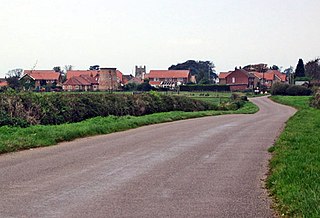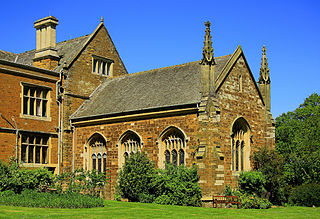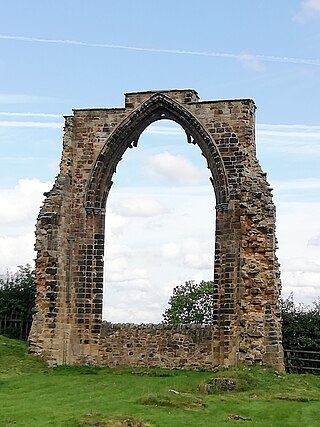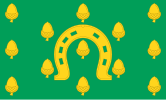
Croxton Kerrial is a village and civil parish in the Melton borough of Leicestershire, England, 6.6 miles (10.6 km) south-west of Grantham, 7.9 miles (12.7 km) north-east of Melton Mowbray, and 0.5 miles (0.8 km) west of Leicestershire's border with Lincolnshire. The civil parish includes the village of Branston and had a population of 530 at the 2011 census.

Halesowen Abbey was a Premonstratensian abbey in Halesowen, England of which only ruins remain. Founded by Peter des Roches with a grant of land from King John, the abbey's official year of inauguration was 1218. It acquired two daughter abbeys and a dependent priory. It also acquired a considerable range of estates, mostly concentrated within the region, and a number of churches, which it appropriated after being granted the advowsons. The abbey's manorial court records have survived in large part, portraying a discontented community, driven to many acts of resistance and at one point to challenge the abbey's very existence. The abbey played no great part in the affairs of its order, although it was represented at all levels. At least one abbot attracted serious criticism from within the order, which attempted to remove him. Its canons observed the Rule of St Augustine to a varying degree, with some serious lapses, at least in the late 15th century, when the order's visitor uncovered widespread sexual exploitation of local women. The abbey was moderately prosperous and survived the suppression of the lesser monasteries. It was dissolved in 1538.

Beeleigh Abbey near Maldon in Essex, England, was a monastery constructed in 1180 for the Order of Canons Regular of Prémontré, as known as the Norbertines or Premonstratensians. The order linked the change of the separate life of monks in the 12th century with the retrospective life of the friar, who was considerably more active.

Leiston Abbey outside the town of Leiston, Suffolk, England, was a religious house of Canons Regular following the Premonstratensian rule, dedicated to St Mary. Founded in c. 1183 by Ranulf de Glanville, Chief Justiciar to King Henry II (1180-1189), it was originally built on a marshland isle near the sea, and was called "St Mary de Insula". Around 1363 the abbey suffered so much from flooding that a new site was chosen and it was rebuilt further inland for its patron, Robert de Ufford, 1st Earl of Suffolk (1298-1369). However, there was a great fire in c. 1379 and further rebuilding was necessary.

Cockersand Abbey is a former abbey and former civil parish near Cockerham in the City of Lancaster district of Lancashire, England. It is situated near the mouth of the River Cocker.

Barlings Abbey, Lincolnshire, was a Premonstratensian monastery in England, founded in 1154, as a daughter house of the Abbey of St. Mary and St. Martial in Newsham.

Blanchland Abbey at Blanchland, in the English county of Northumberland, was founded as a premonstratensian priory in 1165 by Walter de Bolbec II, and was a daughter house of Croxton Abbey in Leicestershire. It became an abbey in the late 13th century. The 16th century former Abbot's house is a Grade II* listed building and the whole site is a Scheduled Ancient Monument.

Tupholme Abbey was a Premonstratensian abbey close to the River Witham some 10+1⁄2 miles (16.9 km) east of the city of Lincoln, England. The Witham valley in Lincolnshire is notable for its high concentration of monasteries—there were six on the east bank and three on the west—all presumably drawn to the area by the usefulness of the River Witham for transport and by the wealth that it transported. The abbey was largely destroyed by 1538, after being seized during Henry VIII's Dissolution of the Monasteries.

Caldwell Priory was a priory of Canons of the Holy Sepulchre in Bedfordshire, England, from circa 1154 to 1536. It was situated in the south-west of Bedford on the south bank of the River Great Ouse.
Hornby Priory was an English Premonstratensian monastic house in Hornby, Lancashire. Dedicated to St Wilfrid, the priory was a dependent cell of Croxton Abbey in Leicestershire. It was probably founded by Roger de Montbegon of Hornby, otherwise his father Adam or grandfather Roger.

Launde Priory is a former Augustinian priory in Leicestershire, England. Its successor Launde Abbey is used as a conference and retreat centre by the Church of England dioceses of Leicester and Peterborough.

Owston Abbey was an Augustinian monastery in Owston, Leicestershire, England.
Newbo Abbey was a Premonstratensian house of canons regular in Lincolnshire, England, dedicated to the Assumption of Mary.

Newsham Abbey was an abbey in Newsham, a small hamlet north of Brocklesby village in Lincolnshire, England. Founded by Peter of Gousla in 1143, Newsham was a daughter house of the Abbey of Licques, near Calais, and the first Premonstratensian house established in England.
Sulby Abbey was a Premonstratensian house in Northamptonshire, England, founded in 1155 as daughter house of the Abbey of St. Mary and St. Martial in Newsham.
Longleat Priory was a priory near Warminster, Wiltshire, in the south of England. A short-lived priory was established and dissolved near to Longleat in the 12th century. The main priory was established before 1233 and was under the control of the Dean of Salisbury until its dissolution in 1529.

The Abbey of Saint Mary de Pratis, more commonly known as Leicester Abbey, was an Augustinian religious house in the city of Leicester, in the East Midlands of England. The abbey was founded in the 12th century by the Robert de Beaumont, 2nd Earl of Leicester, and grew to become the wealthiest religious establishment within Leicestershire. Through patronage and donations the abbey gained the advowsons of countless churches throughout England, and acquired a considerable amount of land, and several manorial lordships. Leicester Abbey also maintained a cell at Cockerham Priory, in Lancashire. The Abbey's prosperity was boosted through the passage of special privileges by both the English Kings and the Pope. These included an exemption from sending representatives to parliament and from paying tithe on certain land and livestock. Despite its privileges and sizeable landed estates, from the late 14th century the abbey began to suffer financially and was forced to lease out its estates. The worsening financial situation was exacerbated throughout the 15th century and early 16th century by a series of incompetent, corrupt and extravagant abbots. By 1535 the abbey's considerable income was exceeded by even more considerable debts.

Dale Abbey, also known as the Abbey of Stanley Park, was a religious house, close to Ilkeston in Derbyshire. Its ruins are located at the village of Dale Abbey, which is named after it. Its foundation legend portrays it as developing from a hermitage, probably in the early 12th century. After several false starts, it was finally constituted as an abbey in 1204. It was affiliated to the Premonstratensians, an order of canons regular in which it played, at times, a leading part among English Houses. It acquired a large number of small properties, concentrated in areas of the East Midlands, developed a network of granges and appropriated a number of lucrative parish churches. Its discipline and reputation varied considerably, particularly in the 15th century, and it seems to have fallen away from the originally austerity. By 1536 its income was well below the threshold set for the Dissolution of Lesser Monasteries. Although there were accusations of grave immorality, the abbey was allowed to pay a fine to continue its existence until 1538.


















